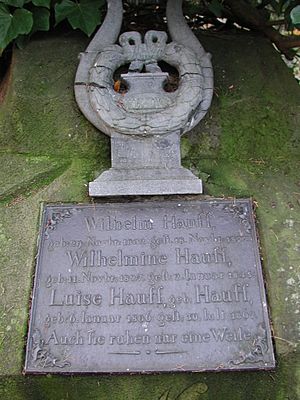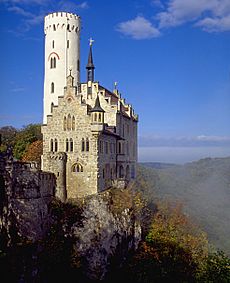Wilhelm Hauff facts for kids
Quick facts for kids
Wilhelm Hauff
|
|
|---|---|
 |
|
| Born | 29 November 1802 Stuttgart, Württemberg |
| Died | 18 November 1827 (aged 24) Germany |
| Occupation | Poet, novelist |
| Language | German |
| Genre | Poetry, fiction |
Wilhelm Hauff (born November 29, 1802 – died November 18, 1827) was a German writer. He was known for his poems and novels. He lived in a region of Germany called Württemberg.
Wilhelm Hauff's Early Life
Wilhelm Hauff was born in Stuttgart, a city in Germany. His father, August Friedrich Hauff, worked for the government. His mother was Hedwig Wilhelmine Elsaesser Hauff. Wilhelm was one of four children in his family.
When Wilhelm was seven years old, his father passed away. His mother then moved to Tübingen. Wilhelm mostly taught himself by reading books in his grandfather's library there. In 1818, he went to a special school called Klosterschule in Blaubeuren. Later, in 1820, he began studying at the University of Tübingen. He spent four years there, studying philosophy and theology.
Wilhelm Hauff's Famous Writings
After finishing university, Wilhelm Hauff became a tutor. He taught the children of General Baron Ernst Eugen von Hugel. For these children, he wrote his famous Märchen, which means fairy tales. He published these stories in a book called Fairytale Almanac of 1826.
Many of his fairy tales are still very popular today. Some of these include:
- Der kleine Muck (The Story of Little Muck)
- Kalif Storch (Caliph Stork)
- Die Geschichte von dem Gespensterschiff (The Tale of the Ghost Ship)
These stories are often set in the Middle East.
Other popular tales by Hauff are set in Germany:
- Der Zwerg Nase (Little Longnose)
- Das kalte Herz (The Cold Heart or The Marble Heart)
- Das Wirtshaus im Spessart (The Spessart Inn)
Hauff also wrote other books. He started a book called Memoirs of Beelzebub in 1826. He also wrote The Man in the Moon in 1825. This book was a funny copy of another author's style.
Wilhelm Hauff was inspired by the novels of Walter Scott. He wrote a historical novel called Lichtenstein: Romantic Saga from the History of Württemberg in 1826. This book became very popular, especially in the Swabia region of Germany. It told a story from the time of Duke Ulrich. The novel was so inspiring that a later duke rebuilt the real Lichtenstein Castle to look like Hauff's description.
Hauff traveled to France, the Netherlands, and northern Germany. During his travels, he wrote more stories. These included the second part of Memoirs of Beelzebub. He also wrote short novels like The Beggar of the Pont des Arts. His novella Phantasien im Bremer Ratskeller (The Wine-Ghosts of Bremen) is considered a masterpiece. He also wrote some short poems that became popular folk songs. One of these is "Morgenrot, Morgenrot, leuchtest mir zum frühen Tod?" ("Dawn's light, you are lighting my way to early death?"). Another is "Steh ich in finstrer Mitternacht" ("I stand in the darkest midnight").
In 1827, Hauff became the editor of a newspaper called the Stuttgart Morgenblatt. The next month, he married his cousin, Luise Hauff. Sadly, his life was cut short. He died from typhoid fever on November 18, 1827.
Images for kids
See also
 In Spanish: Wilhelm Hauff para niños
In Spanish: Wilhelm Hauff para niños
- “Auf Posten,” a lieder by Elise Schmezer (1810-1856) based on text by Hauff
- Das kalte Herz (The Heart of Stone), feature film, 1950, East Germany, director Paul Verhoeven.
- Geschichte vom kleinen Muck, a 1953 film.
- Калиф-аист (Caliph Stork), Soviet live action film, 1968.
- Сказка, рассказанная ночью, Soviet feature film based on the stories The Marble Heart and The Spessart Inn, USSR, 1981.
- Халиф-аист, Soviet animation, based on one of the stories (Caliph Stork), 1981.
- Little Longnose, a 2003 Russian animated feature based on one of his stories.




